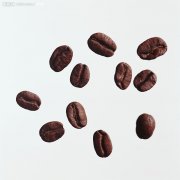Guidelines for brewing golden cups of coffee
What is the best? what is the appropriate ratio of sour to bitter taste? all these need to be adjusted according to individual tastes. If you cook them for others, you should choose beans according to the preferences of coffee drinkers, change the hot water temperature, extract time and grinding degree, and find the best value.
The taste of coffee from light to medium roasting is mainly low molecular weight and medium molecular weight sour and sweet taste, but too many defective beans or improper roasting, even shallow roasting will produce a thankless bitter and salty taste. As for deep baking, it is mainly bitter and salty with high molecular weight. Unless you are familiar with the deep baking methods of traditional drum roasters, it is not easy to break the fate of deep baked beans with salty taste. But deep baking is by no means useless. The rarest deep-baked flavor spectrum is "thick but not bitter, sweet and mellow to moisten the throat". After experiments, it is not a myth. Generally speaking, 70%-72% of roasted coffee beans are insoluble in water, and water-soluble flavor ingredients account for only 28%-30% of the weight of cooked beans. What are the contents of these soluble flavors? SCAA senior consultant Lin GE's masterpiece, "Coffee Cup tester Handbook," contains relevant data.
How to brew coffee is the best to drink, and how to make coffee is the best. Today, Brista Coffee West Point training College will tell you the correct brewing and brewing requirements of coffee. Baristas who have been in the industry for many years all know that the golden ratio of coffee brewing is in [1: 13. 6: 1]. Because this ratio range is the easiest to brew out the good taste of coffee, extract the delicious part of the coffee. This range to meet the optimal extraction rate and suitable concentration is also known as the "Golden Cup Criterion], which has always been recognized by coffee researchers. In recent years, due to the advent of the Magic extraction Analyzer (ExtractMOJO), this [Golden Cup Criterion] has become a popular extraction theory for high-quality coffee in Europe and the United States.
The earliest Golden Cup Criterion was proposed by Ernest Earl Lockhart, PhD in chemistry at the Massachusetts Institute of Technology, who found that under the premise of fresh coffee, extraction rate and concentration are the two keys to determine whether a cup of coffee is delicious or not. Then invite the public to try it, and sum up the extraction rate and intensity that the Chinese like. This is the virgin version of the Golden Cup Criterion. Later, it was revised to establish an appropriate extraction standard, and Norway, Britain and Brazil also used this theory as a learning blueprint to develop their own preferred Golden Cup criteria. Basically, all countries have a consensus on the range of the best extraction rate, using the same standard of 18%, 22%, but each has its own preference for the most palatable intensity.
One of the gold cup criteria: 18% / 22% gold extraction rate
According to the research of Dr. Lockhart and Ringo, a senior consultant of SCAA (American Fine Coffee Association), as far as coffee extraction is concerned, the dissolution rates of flavor molecules and hot water often vary according to molecular weight and polarity. Coincidentally, the low molecular weight sour flavors of flowers and fruits, nuts and toast, as well as the cereal and rice flavors produced at the initial stage of the Mena reaction will be dissolved preferentially, followed by medium molecular weight flavors such as caramel, cream and chocolate, followed by high molecular weight resins, dark chocolate and caramel, which are mainly bitter and salty, sweet and bitter, wine, spice and coke.
70% of coffee beans are water-insoluble fiber, and soluble flavors account for only 30% of the weight of cooked beans. Therefore, the extraction rate is too high or too low, indicating that the flavor extracted from brewing coffee is too much or too little, which will affect the taste of coffee. Therefore, when brewing coffee, if the flavor extracted is too much, if 30% of the flavor is extracted, it is certain that the extraction is excessive, and there will be unpalatable bitterness, saltiness and throat bite; if only less than 18% of the soluble matter is extracted, it is easy to lack of extraction, and it is easy to have inactive dead acid and half-cooked grain flavor and astringency, which is uncomfortable. And if the extraction rate happens to fall in the golden range of 18%, 22%, the astringency and dead acidity of the first extraction are cleverly neutralized by the sweet aromatics extracted immediately after, and then Baiwei is in harmony.
The main factors affecting the extraction rate are brewing water temperature, extraction time, stirring force and baking degree, coffee powder amount and grinding fineness. The higher the water temperature, the longer the brewing time, the harder the stirring or the deeper the baking degree, the higher the extraction rate. On the contrary, the more it will pull down the extraction rate, resulting in insufficient extraction.
It is worth mentioning that the relationship between baking degree and extraction rate is that the shallower the roasted coffee fiber is, the harder it is to dissolve, so it needs higher water temperature, longer brewing time or finer grinding degree to avoid insufficient extraction. On the contrary, the deeper the roasted coffee is, the softer the fiber is, and the easier it is to dissolve the ingredients. It is appropriate to use a lower water temperature, a shorter time, or a thicker degree of grinding, so as to avoid excessive extraction. Therefore, the shallow roasted coffee is obviously more able to withstand the stronger extraction than the deep roasting.
Important Notice :
前街咖啡 FrontStreet Coffee has moved to new addredd:
FrontStreet Coffee Address: 315,Donghua East Road,GuangZhou
Tel:020 38364473
- Prev

SCAA Coffee Flavor Wheel learns the sour, sweet, bitter and salty of coffee
What is the best overall taste, and what is the appropriate ratio of sour to bitter taste? these all need to be adjusted according to individual tastes. If they are cooked for others, beans should be selected according to the preferences of coffee drinkers. Change the hot water temperature, extraction time and grinding degree, to find the best value. The taste of coffee roasted from light to medium is low molecular weight and middle molecular weight.
- Next

The method of "steaming" Coffee for the purpose of making Coffee individual Coffee
How to brew coffee is the best to drink, and how to make coffee is the best. Today, Brista Coffee West Point training College will tell you the correct brewing and brewing requirements of coffee. Baristas who have been in the industry for many years all know that the golden ratio of coffee brewing is in [1: 13. 6: 1]. Because this ratio range is the easiest to brew out the good taste of coffee, extract the delicious part of the coffee. This interval
Related
- Beginners will see the "Coffee pull flower" guide!
- What is the difference between ice blog purified milk and ordinary milk coffee?
- Why is the Philippines the largest producer of crops in Liberia?
- For coffee extraction, should the fine powder be retained?
- How does extracted espresso fill pressed powder? How much strength does it take to press the powder?
- How to make jasmine cold extract coffee? Is the jasmine + latte good?
- Will this little toy really make the coffee taste better? How does Lily Drip affect coffee extraction?
- Will the action of slapping the filter cup also affect coffee extraction?
- What's the difference between powder-to-water ratio and powder-to-liquid ratio?
- What is the Ethiopian local species? What does it have to do with Heirloom native species?

